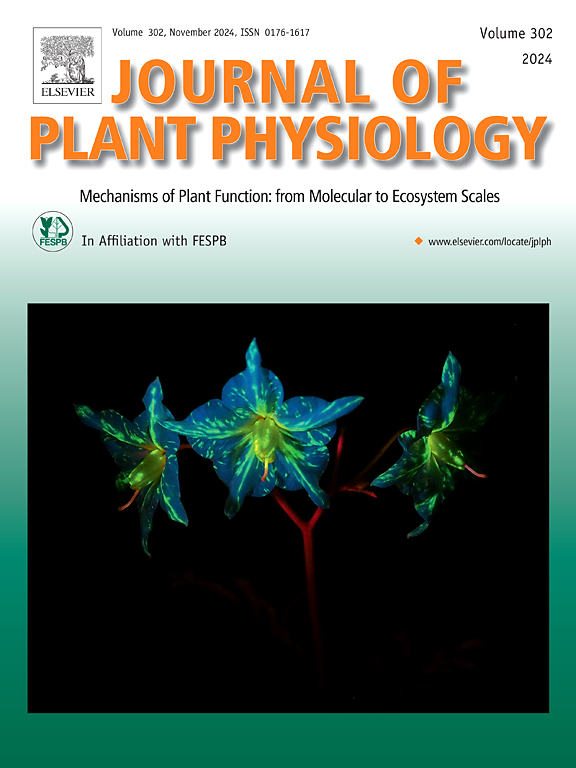破解蛋白质组学、转录组学、基因组学和集成组学,增强植物的非生物、生物和气候变化胁迫适应能力。
IF 4
3区 生物学
Q1 PLANT SCIENCES
引用次数: 0
摘要
随着我们的星球面临越来越多的环境挑战,如生物压力、非生物压力源和气候变化,了解作物植物应激反应的复杂机制至关重要。近年来,LC-MS、IT-MS、MALDI-MS、DIGE、ESTs、SAGE、WGS、GWAS、GBS、2D-PAGE、CRISPR-Cas、cDNA-AFLP、HLS、HRPF、MPSS、CAGE、MAS、IEF、MudPIT、SRM/MRM、SWATH-MS、ESI等蛋白质组学、转录组学和基因组学技术的整合,极大地提高了我们对生态系统/生态胁迫适应平衡的分子途径和调控网络的理解能力。本文综述了利用这些多组学方法(包括代谢组学、离子组学)对抗非生物(盐度、温度(冷/冻/冷/热)、洪水(缺氧)、干旱、重金属/液体)、生物(真菌、细菌、病毒、害虫、昆虫(蚜虫、毛虫、飞蛾、螨虫、线虫)和气候变化胁迫(臭氧、紫外线辐射、温室气体、二氧化碳)的研究现状。这些策略可以加快作物改良,并作为具有高吞吐量和即时数据库生成率的强大工具。它们还提供了一个平台来解释复杂的、系统的信号通路,并了解不同的环境刺激如何通过改变RAB18、KIN1、RD29B、OsCIPK03、OsSTL、SIAGL、bZIP、SnRK、ABF等应激反应基因的表达,在细胞和分子水平上引起表型反应。这篇综述讨论了成功应用这些组学工具来增强植物抗逆性的各种案例研究。最后,它强调了利用这些方法对抗压力的挑战和未来前景,强调了跨学科合作和生物技术进步对可持续农业和粮食安全的必要性。本文章由计算机程序翻译,如有差异,请以英文原文为准。
Decrypting proteomics, transcriptomics, genomics, and integrated omics for augmenting the abiotic, biotic, and climate change stress resilience in plants
As our planet faces increasing environmental challenges, such as biotic pressures, abiotic stressors, and climate change, it is crucial to understand the complex mechanisms that underlie stress responses in crop plants. Over past few years, the integration of techniques of proteomics, transcriptomics, and genomics like LC-MS, IT-MS, MALDI-MS, DIGE, ESTs, SAGE, WGS, GWAS, GBS, 2D-PAGE, CRISPR-Cas, cDNA-AFLP, HLS, HRPF, MPSS, CAGE, MAS, IEF, MudPIT, SRM/MRM, SWATH-MS, ESI have significantly enhanced our ability to comprehend the molecular pathways and regulatory networks, involved in balancing the ecosystem/ecology stress adaptation. This review offers thorough synopsis of the current research on utilizing these multi-omics methods (including metabolomics, ionomics) for battling abiotic (salinity, temperature (chilling/freezing/cold/heat), flood (hypoxia), drought, heavy metals/loids), biotic (pathogens like fungi, bacteria, virus, pests, and insects (aphids, caterpillars, moths, mites, nematodes) and climate change stress (ozone, ultraviolet radiation, green house gases, carbon dioxide). These strategies can expedite crop improvement, and act as powerful tools with high throughput and instant database generation rates. They also provide a platform for interpreting intricate, systematic signalling pathways and knowing how different environmental stimuli cause phenotypic responses at cellular and molecular level by changing the expression of stress-responsive genes like RAB18, KIN1, RD29B, OsCIPK03, OsSTL, SIAGL, bZIP, SnRK, ABF. This review discusses various case studies that exemplify the successful implementation of these omics tools to enhance stress tolerance in plants. Finally, it highlights challenges and future prospects of utilizing these approaches in combating stress, emphasizing the need for interdisciplinary collaborations and bio-technological advancements for sustainable agriculture and food security.
求助全文
通过发布文献求助,成功后即可免费获取论文全文。
去求助
来源期刊

Journal of plant physiology
生物-植物科学
CiteScore
7.20
自引率
4.70%
发文量
196
审稿时长
32 days
期刊介绍:
The Journal of Plant Physiology is a broad-spectrum journal that welcomes high-quality submissions in all major areas of plant physiology, including plant biochemistry, functional biotechnology, computational and synthetic plant biology, growth and development, photosynthesis and respiration, transport and translocation, plant-microbe interactions, biotic and abiotic stress. Studies are welcome at all levels of integration ranging from molecules and cells to organisms and their environments and are expected to use state-of-the-art methodologies. Pure gene expression studies are not within the focus of our journal. To be considered for publication, papers must significantly contribute to the mechanistic understanding of physiological processes, and not be merely descriptive, or confirmatory of previous results. We encourage the submission of papers that explore the physiology of non-model as well as accepted model species and those that bridge basic and applied research. For instance, studies on agricultural plants that show new physiological mechanisms to improve agricultural efficiency are welcome. Studies performed under uncontrolled situations (e.g. field conditions) not providing mechanistic insight will not be considered for publication.
The Journal of Plant Physiology publishes several types of articles: Original Research Articles, Reviews, Perspectives Articles, and Short Communications. Reviews and Perspectives will be solicited by the Editors; unsolicited reviews are also welcome but only from authors with a strong track record in the field of the review. Original research papers comprise the majority of published contributions.
 求助内容:
求助内容: 应助结果提醒方式:
应助结果提醒方式:


